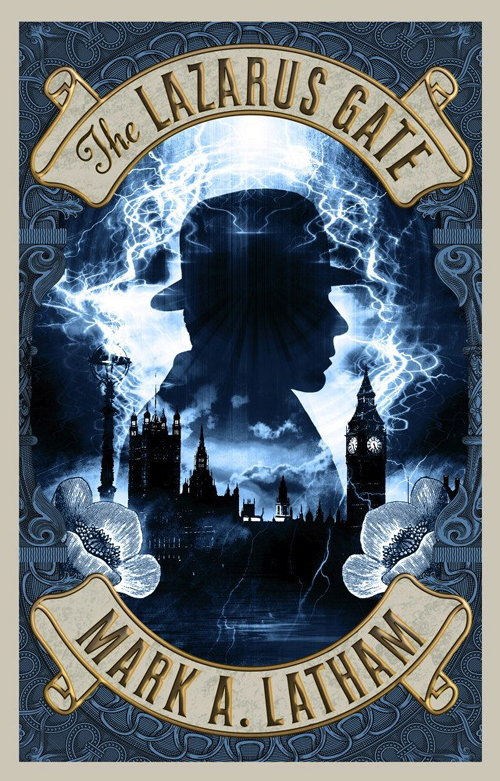
Rather like zombies and superheroes, steampunk is starting to crumble beneath the weight of its popularity. An endless avalanche of “hop aboard the bandwagon” creators has diluted its freshness. Many books set in the Victorian era feature stock characters like the usual “Polly Parasol” type, a proper Englishwoman who enjoys tea after kicking the ass of evildoers using kung fu or James Bond gadgets.
The Lazarus Gate is noticeably different from the fluffy and frivolous steampunk potboilers. It is grimmer and more serious, with sizable dollops of paranoia, double-dealing and outright horror. The hero is a conflicted man struggling with a number of daunting issues, both supernatural and personal. And the Victorian London wherein the bulk of the book is set is the real Victorian London…no dirigibles floating overhead or robot bobbies patrolling the streets. However, that London is not the only one we are dealing with….
It’s clear than author Mark Latham knows the London of the 1890s very well. His description of the streets, buildings and landmarks is spot on, almost to the point where the city becomes a character itself. And his mastery of the period language is also strong. If you love the cadence of authors like Arthur Conan Doyle and H.G. Wells, you’ll enjoy the verbiage here. Although it can be described as overripe on several occasions, it rings so true that it would take a real stickler to have issues with it.
The Lazarus Gate unfolds in a peculiar way with strange pacing. The opening third comes across like a stodgy police procedural, with the hero trying to piece clues together. It reminds me rather of a stuffy old bobby with a walrus mustache plodding along slowly but steadily. Then the novel takes a turn for the bizarre and the fantastic and suddenly it becomes delirious horror, with some shocking violence and grotesque imagery. After a crescendo of terror, it then becomes almost laughably idyllic and romantic for a while. Latham builds up steam for the final confrontation, which features a rip-roaring naval battle and even a good serving of Lovecraftian horror. The coda of the book is rather grim and puts our hero through some very difficult moral quandaries.
There are times when science and sorcery become indistinguishable here. There are also tantalizing hints of a much larger and more epic story that is yet to unfold. At certain points, Latham reveals information in huge “dumps” that tend to be ungainly. The initial story of contact with the “Other Side” is one of these. But while these info dumps are often awkward, Latham has a great eye for detail and he wraps up a lot of loose ends…except for those which he leaves dangling for future volumes.
A brief run-through of The Lazarus Gate will give the reader a better idea of what makes the story different from the usual steampunk pastiche.
We start in Burma circa 1890 as Captain John Hardwick is released from the hell of a Burmese prison where he has been languishing. Hardwick has had a dreadful experience there, suffering torture and starvation at the hands of his captors. He returns to London after a prisoner exchange in frail health and struggling with an opium habit. It seems his former jailers injected him with the drug in a failed attempt to break his will. He is now looking to put his life back together and deal with the estate left behind by his father, a deceased war hero.
It isn’t long before Hardwick is recruited by the members of a highly exclusive and secretive organization known as the Apollonian Club. He is given the task of trying to solve a series of mysterious bomb attacks that have terrorized London. The public is told that the crimes are being committed by “Irish dynamiters” but the police are baffled by how the bombers are able to apparently disappear into thin air. Hardwick is confused as to why he was chosen for the task but accepts the charge and is given access to the considerable resources of the Club.
With the aid of fellow Club member Ambrose Hanlocke, a rather roguish and shady character, Hardwick throws himself into the mystery. This is the part of the book that drags a bit, as painstaking detective work leads Hardwick to believe that the bombers are more than just political malcontents. He determines that they seem to be using some kind of gate that allows them to easily disappear from the scene of the crime. Using geographic knowledge of where the past bombings took place, John believes he can predict where future attacks will transpire. And he also discovers that they somehow are connected to spiritualists and mediums.
When investigating one such spiritualist, things become really bizarre. The medium is found dead and a trap is sprung. Hardwick encounters a sinister looking woman and the room he is in seems to become distorted and otherworldly. Then the building he is in simply explodes. Hardwick survives but knows he is in the middle of something unearthly.
At a secret meeting of some of the most important people in England, Hardwick learns the unbelievable truth: the crimes are being committed by agents from an alternate version of London. These “Othersiders” are preparing for an all-out invasion of our own world and they are using their superior knowledge of transdimensional portals to attack and then escape. The American psychologist and philosopher William James (one of the few “real” characters to appear in The Lazarus Gate) tells how he himself stumbled upon a portal and was transported to the “other” London.
 According to James, the paranormal and the supernatural are much more accepted in the other world, which is inhabited by duplicates of people in the “real” world. Psychics there are treated as little better than slaves and are used by the powers that be. But the Other Side is itself being invaded by demonic entities and the inhabitants there plan to move through portals to take over our world.
According to James, the paranormal and the supernatural are much more accepted in the other world, which is inhabited by duplicates of people in the “real” world. Psychics there are treated as little better than slaves and are used by the powers that be. But the Other Side is itself being invaded by demonic entities and the inhabitants there plan to move through portals to take over our world.
Hardwick can hardly believe what he’s hearing but soon circumstances force him to accept the fact that “Othersiders” are invading our reality. What is worse is that their agents will often kill their doubles in this reality and then take their place. Who can be trusted? Signs already suggest that all levels of society have been infiltrated. And this is where The Lazarus Gate begins to take off, as Latham creates a feeling of absolute paranoia. Hardwick begins to distrust those around him, especially Hanlocke.
There is one man in England who knows more than anyone else about the Othersiders and their plans. But he is considered the most dangerous man in the British Empire. He is a Chinese national named Tsun Pen but more widely known as The Artist. A sinister crime lord who deals in secrets and blackmail, even the leaders of England fear his reach. And now he seems to be working with the Othersiders. Hardwick’s next assignment is to take a crack team of police and enter the Artist’s lair. No one yet has succeeded in penetrating Tsun Pen’s stronghold and returning alive.
The Artist and his underlings seem at first to be cut from the archaic mold of Fu Manchu and similar “yellow peril” characters. And there is a good deal of Fu Manchu in him. He rules a dark and sleazy Chinatown kingdom full of opium dens and gambling enclaves and is served by an army of Oriental assassins including his bodyguard Hu, who even sports an iron hook hand. But there is more to The Artist than just this superficial layer. Although blind, he has the ability to paint symbolic visions of the future…a talent he has even used on behalf of the British government. And he suffers from a hideous secret deformity that makes him truly repellent. He is also well-spoken and polite, even as he commits terrible atrocities and takes advantage of his position of information broker for two worlds. He is a truly magnetic and unforgettable villain.
Hardwick and his agents raid The Artist’s house of horrors but it isn’t long before their plans are completely ruined. The Artist captures Hardwick and submits him to some very grueling torture including mutilation. He also reveals the secret of his origin…and the truth of what Hardwick is really up against. The leader of the Othersiders is a renegade from the “real” London known as Lazarus, who knows all the secrets of our world. Lazarus has been behind the bombings and is preparing for a great invasion of our dimension using a huge portal called The Lazarus Gate.
These scenes in Tsun Pen’s lair are the highlight of the book and where it really stretches into horror territory. His weakness for opium is fully exploited by The Artist, making things even more nightmarish. And then he is tortured and kept in the same room as The Artist’s loathsome “pets,” who are quite grotesque. It makes for a nail-biting read.
Hardwick does manage to escape the clutches of The Artist but he is more dead than alive. He awakens after a period of delirium to find himself in a gypsy camp in a forest outside London. The camp is dominated by five gypsy sisters who all have “The Sight.” Their queen is the lovely Rosanna and it was her mystic vision that told her where to find Hardwick. The wounded soldier is nursed back to health by the outcasts and as one might imagine, a relationship develops with Rosanna. But being the stiff upper lip British soldier that he is, Hardwick knows that duty calls and he must return to London to try and thwart the impending invasion of The Othersiders. The most devastating secret that Tsun Pen revealed to him was the actual identity of Lazarus – a revelation that hits close to home.
After some rather too idyllic scenes with the gypsies, Hardwick is again drawn into the conflict. There is a very unique and disturbing séance scene where we start to get a hint of what kind of horror is driving the Othersiders to steal our world. Ultimately, Hardwick finds the Achilles Heel of Lazarus and heads to confront him directly as he launches a naval invasion using London Bridge itself as the Lazarus Gate. There’s some rip-roaring battle scenes and a brief look into the Other Side, where Hardwick sees the terror that has befallen the other London: a sky turned to flame, flying monsters attacking the city and looming in the sky, a monstrosity that is described as if it might be Cthulhu himself.
There is a resolution to the immediate threats but not without great cost and I’ll leave you to discover the surprises that Latham has in store. I appreciated the final chapter, where loose ends are wrapped up but not in a particularly tidy way. Hardwick learns exactly why he was specifically chosen by the Apollonian Club and the hard cost of being one of their agents. Sometimes small evils must be done for a greater good. But Hardwick realizes what a slippery slope that can be. Latham’s writing here is hard edged and unsentimental and reminds me a lot of John le Carre’s unglamorous description of a spy’s morally conflicted life.
The Lazarus Gate has its flaws but its approach to Victorian fantasy is detailed and refreshing. John Hardwick emerges as a fully formed character who undergoes a striking evolution over the course of the book. His adventures with the Apollonian Club and the supernatural are just beginning. It looks like I will be along for the ride and if a combination of Arthur Conan Doyle, H.G Wells, H.P. Lovecraft and even Ian Fleming sounds intriguing, you should come along as well.














